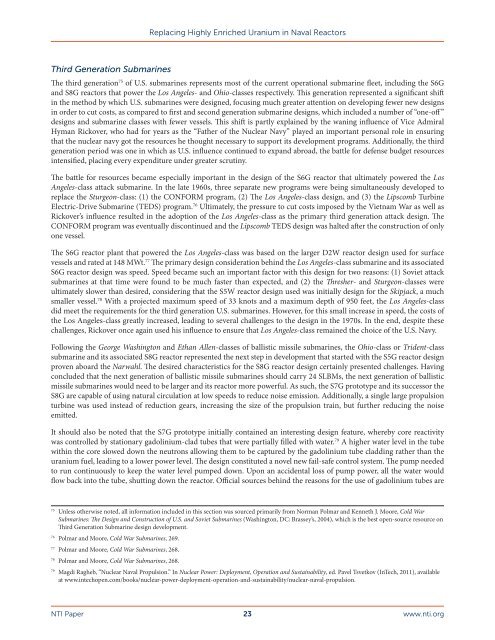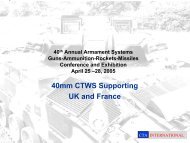Replacing Highly Enriched Uranium in Naval Reactors
Replacing_HEU_in_Naval_Reactors_Report_FINAL
Replacing_HEU_in_Naval_Reactors_Report_FINAL
Create successful ePaper yourself
Turn your PDF publications into a flip-book with our unique Google optimized e-Paper software.
<strong>Replac<strong>in</strong>g</strong> <strong>Highly</strong> <strong>Enriched</strong> <strong>Uranium</strong> <strong>in</strong> <strong>Naval</strong> <strong>Reactors</strong><br />
Third Generation Submar<strong>in</strong>es<br />
The third generation 75 of U.S. submar<strong>in</strong>es represents most of the current operational submar<strong>in</strong>e fleet, <strong>in</strong>clud<strong>in</strong>g the S6G<br />
and S8G reactors that power the Los Angeles- and Ohio-classes respectively. This generation represented a significant shift<br />
<strong>in</strong> the method by which U.S. submar<strong>in</strong>es were designed, focus<strong>in</strong>g much greater attention on develop<strong>in</strong>g fewer new designs<br />
<strong>in</strong> order to cut costs, as compared to first and second generation submar<strong>in</strong>e designs, which <strong>in</strong>cluded a number of “one-off ”<br />
designs and submar<strong>in</strong>e classes with fewer vessels. This shift is partly expla<strong>in</strong>ed by the wan<strong>in</strong>g <strong>in</strong>fluence of Vice Admiral<br />
Hyman Rickover, who had for years as the “Father of the Nuclear Navy” played an important personal role <strong>in</strong> ensur<strong>in</strong>g<br />
that the nuclear navy got the resources he thought necessary to support its development programs. Additionally, the third<br />
generation period was one <strong>in</strong> which as U.S. <strong>in</strong>fluence cont<strong>in</strong>ued to expand abroad, the battle for defense budget resources<br />
<strong>in</strong>tensified, plac<strong>in</strong>g every expenditure under greater scrut<strong>in</strong>y.<br />
The battle for resources became especially important <strong>in</strong> the design of the S6G reactor that ultimately powered the Los<br />
Angeles-class attack submar<strong>in</strong>e. In the late 1960s, three separate new programs were be<strong>in</strong>g simultaneously developed to<br />
replace the Sturgeon-class: (1) the CONFORM program, (2) The Los Angeles-class design, and (3) the Lipscomb Turb<strong>in</strong>e<br />
Electric-Drive Submar<strong>in</strong>e (TEDS) program. 76 Ultimately, the pressure to cut costs imposed by the Vietnam War as well as<br />
Rickover’s <strong>in</strong>fluence resulted <strong>in</strong> the adoption of the Los Angeles-class as the primary third generation attack design. The<br />
CONFORM program was eventually discont<strong>in</strong>ued and the Lipscomb TEDS design was halted after the construction of only<br />
one vessel.<br />
The S6G reactor plant that powered the Los Angeles-class was based on the larger D2W reactor design used for surface<br />
vessels and rated at 148 MWt. 77 The primary design consideration beh<strong>in</strong>d the Los Angeles-class submar<strong>in</strong>e and its associated<br />
S6G reactor design was speed. Speed became such an important factor with this design for two reasons: (1) Soviet attack<br />
submar<strong>in</strong>es at that time were found to be much faster than expected, and (2) the Thresher- and Sturgeon-classes were<br />
ultimately slower than desired, consider<strong>in</strong>g that the S5W reactor design used was <strong>in</strong>itially design for the Skipjack, a much<br />
smaller vessel. 78 With a projected maximum speed of 33 knots and a maximum depth of 950 feet, the Los Angeles-class<br />
did meet the requirements for the third generation U.S. submar<strong>in</strong>es. However, for this small <strong>in</strong>crease <strong>in</strong> speed, the costs of<br />
the Los Angeles-class greatly <strong>in</strong>creased, lead<strong>in</strong>g to several challenges to the design <strong>in</strong> the 1970s. In the end, despite these<br />
challenges, Rickover once aga<strong>in</strong> used his <strong>in</strong>fluence to ensure that Los Angeles-class rema<strong>in</strong>ed the choice of the U.S. Navy.<br />
Follow<strong>in</strong>g the George Wash<strong>in</strong>gton and Ethan Allen-classes of ballistic missile submar<strong>in</strong>es, the Ohio-class or Trident-class<br />
submar<strong>in</strong>e and its associated S8G reactor represented the next step <strong>in</strong> development that started with the S5G reactor design<br />
proven aboard the Narwahl. The desired characteristics for the S8G reactor design certa<strong>in</strong>ly presented challenges. Hav<strong>in</strong>g<br />
concluded that the next generation of ballistic missile submar<strong>in</strong>es should carry 24 SLBMs, the next generation of ballistic<br />
missile submar<strong>in</strong>es would need to be larger and its reactor more powerful. As such, the S7G prototype and its successor the<br />
S8G are capable of us<strong>in</strong>g natural circulation at low speeds to reduce noise emission. Additionally, a s<strong>in</strong>gle large propulsion<br />
turb<strong>in</strong>e was used <strong>in</strong>stead of reduction gears, <strong>in</strong>creas<strong>in</strong>g the size of the propulsion tra<strong>in</strong>, but further reduc<strong>in</strong>g the noise<br />
emitted.<br />
It should also be noted that the S7G prototype <strong>in</strong>itially conta<strong>in</strong>ed an <strong>in</strong>terest<strong>in</strong>g design feature, whereby core reactivity<br />
was controlled by stationary gadol<strong>in</strong>ium-clad tubes that were partially filled with water. 79 A higher water level <strong>in</strong> the tube<br />
with<strong>in</strong> the core slowed down the neutrons allow<strong>in</strong>g them to be captured by the gadol<strong>in</strong>ium tube cladd<strong>in</strong>g rather than the<br />
uranium fuel, lead<strong>in</strong>g to a lower power level. The design constituted a novel new fail-safe control system. The pump needed<br />
to run cont<strong>in</strong>uously to keep the water level pumped down. Upon an accidental loss of pump power, all the water would<br />
flow back <strong>in</strong>to the tube, shutt<strong>in</strong>g down the reactor. Official sources beh<strong>in</strong>d the reasons for the use of gadol<strong>in</strong>ium tubes are<br />
75<br />
Unless otherwise noted, all <strong>in</strong>formation <strong>in</strong>cluded <strong>in</strong> this section was sourced primarily from Norman Polmar and Kenneth J. Moore, Cold War<br />
Submar<strong>in</strong>es: The Design and Construction of U.S. and Soviet Submar<strong>in</strong>es (Wash<strong>in</strong>gton, DC: Brassey’s, 2004), which is the best open-source resource on<br />
Third Generation Submar<strong>in</strong>e design development.<br />
76<br />
Polmar and Moore, Cold War Submar<strong>in</strong>es, 269.<br />
77<br />
Polmar and Moore, Cold War Submar<strong>in</strong>es, 268.<br />
78<br />
Polmar and Moore, Cold War Submar<strong>in</strong>es, 268.<br />
79<br />
Magdi Ragheb, “Nuclear <strong>Naval</strong> Propulsion.” In Nuclear Power: Deployment, Operation and Susta<strong>in</strong>ability, ed. Pavel Tsvetkov (InTech, 2011), available<br />
at www.<strong>in</strong>techopen.com/books/nuclear-power-deployment-operation-and-susta<strong>in</strong>ability/nuclear-naval-propulsion.<br />
NTI Paper 23 www.nti.org



